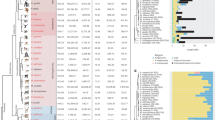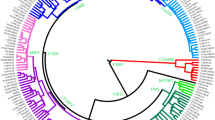Abstract
The mammalian Y chromosome has unique characteristics compared with the autosomes or X chromosomes. Here we report the finished sequence of the chimpanzee Y chromosome (PTRY), including 271 kb of the Y-specific pseudoautosomal region 1 and 12.7 Mb of the male-specific region of the Y chromosome. Greater sequence divergence between the human Y chromosome (HSAY) and PTRY (1.78%) than between their respective whole genomes (1.23%) confirmed the accelerated evolutionary rate of the Y chromosome. Each of the 19 PTRY protein-coding genes analyzed had at least one nonsynonymous substitution, and 11 genes had higher nonsynonymous substitution rates than synonymous ones, suggesting relaxation of selective constraint, positive selection or both. We also identified lineage-specific changes, including deletion of a 200-kb fragment from the pericentromeric region of HSAY, expansion of young Alu families in HSAY and accumulation of young L1 elements and long terminal repeat retrotransposons in PTRY. Reconstruction of the common ancestral Y chromosome reflects the dynamic changes in our genomes in the 5–6 million years since speciation.
This is a preview of subscription content, access via your institution
Access options
Subscribe to this journal
Receive 12 print issues and online access
$209.00 per year
only $17.42 per issue
Buy this article
- Purchase on Springer Link
- Instant access to full article PDF
Prices may be subject to local taxes which are calculated during checkout






Similar content being viewed by others
References
International Human Genome Sequencing Consortium. Initial sequencing and analysis of the human genome. Nature 409, 860–921 (2001).
International Human Genome Sequencing Consortium. Finishing the euchromatic sequence of the human genome. Nature 431, 931–945 (2004).
Gagneux, P. & Varki, A. Genetic differences between humans and great apes. Mol. Phylogenet. Evol. 18, 2–13 (2001).
Fujiyama, A. et al. Construction and analysis of a human-chimpanzee comparative clone map. Science 295, 131–134 (2002).
Ebersberger, I., Metzler, D., Schwarz, C. & Paabo, S. Genomewide comparison of DNA sequences between humans and chimpanzees. Am. J. Hum. Genet. 70, 1490–1497 (2002).
Chou, H.H. et al. Inactivation of CMP-N-acetylneuraminic acid hydroxylase occurred prior to brain expansion during human evolution. Proc. Natl. Acad. Sci. USA 99, 11736–11741 (2002).
Enard, W. et al. Molecular evolution of FOXP2, a gene involved in speech and language. Nature 418, 869–872 (2002).
Sakaki, Y. et al. Human versus chimpanzee chromosome-wide sequence comparison and its evolutionary implication. Cold Spring Harb. Symp. Quant. Biol. 68, 455–460 (2003).
Olson, M.V. & Varki, A. Sequencing the chimpanzee genome: insights into human evolution and disease. Nat. Rev. Genet. 4, 20–28 (2003).
The International Chimpanzee Chromosome 22 Consortium. DNA sequence and comparative analysis of chimpanzee chromosome 22. Nature 429, 382–388 (2004).
Ptak, S.E. et al. Fine-scale recombination patterns differ between chimpanzees and humans. Nat. Genet. 37, 429–434 (2005).
Ohno, S. Sex Chromosomes and Sex-Linked Genes (Springer, Berlin, 1967).
Bishop, C. et al. Extensive sequence homologies between Y and other human chromosomes. J. Mol. Biol. 173, 403–417 (1984).
Graves, J.A. The origin and function of the mammalian Y chromosome and Y-borne genes–an evolving understanding. Bioessays 17, 311–320 (1995).
Lahn, B.T. & Page, D.C. Four evolutionary strata on the human X chromosome. Science 286, 964–967 (1999).
Waters, P.D. et al. The human Y chromosome derives largely from a single autosomal region added to the sex chromosomes 80–130 million years ago. Cytogenet. Cell Genet. 92, 74–76 (2001).
Lahn, B.T., Pearson, N.M. & Jegalian, K. The human Y chromosome, in the light of evolution. Nat. Rev. Genet. 2, 207–216 (2001).
Page, D.C., Harper, M.E., Love, J. & Botstein, D. Occurrence of a transposition from the X-chromosome long arm to the Y-chromosome short arm during human evolution. Nature 311, 119–123 (1984).
Skaletsky, H. et al. The male-specific region of the human Y chromosome is a mosaic of discrete sequence classes. Nature 423, 825–837 (2003).
Ross, M.T. et al. The DNA sequence of the human X chromosome. Nature 434, 325–337 (2005).
Archidiacono, N. et al. Evolution of chromosome Y in primates. Chromosoma 107, 241–246 (1998).
Gerrard, D.T. & Filatov, D.A. Positive and negative selection on mammalian Y chromosomes. Mol. Biol. Evol. 22, 1423–1432 (2005).
Miyata, T. et al. Male-driven molecular evolution: a model and nucleotide sequence analysis. Cold Spring Harb. Symp. Quant. Biol. 52, 863–867 (1987).
Erlandsson, R., Wilson, J.F. & Paabo, S. Sex chromosomal transposable element accumulation and male-driven substitutional evolution in humans. Mol. Biol. Evol. 17, 804–812 (2000).
Makova, K.D. & Li, W.H. Strong male-driven evolution of DNA sequences in humans and apes. Nature 416, 624–626 (2002).
Saitou, N. & Ueda, S. Evolutionary rate of insertions and deletions in non-coding nucleotide sequences of primates. Mol. Biol. Evol. 11, 504–512 (1994).
Stone, A.C. et al. High levels of Y-chromosome nucleotide diversity in the genus Pan. Proc. Natl. Acad. Sci. USA 99, 43–48 (2002).
Filatov, D.A. A gradient of silent substitution rate in the human pseudoautosomal region. Mol. Biol. Evol. 21, 410–417 (2004).
Bailey, J.A. et al. Recent segmental duplications in the human genome. Science 297, 1003–1007 (2002).
Liu, G. et al. Analysis of primate genomic variation reveals a repeat-driven expansion of the human genome. Genome Res. 13, 358–368 (2003).
Hedges, D.J. et al. Differential Alu mobilization and polymorphism among the human and chimpanzee lineages. Genome Res. 14, 1068–1075 (2004).
Orti, R. et al. Conservation of pericentromeric duplications of a 200-kb part of the human 21q22.1 region in primates. Cytogenet. Cell Genet. 83, 262–265 (1998).
Golfier, G. et al. The 200-kb segmental duplication on human chromosome 21 originates from a pericentromeric dissemination involving human chromosomes 2, 18 and 13. Gene 312, 51–59 (2003).
Bonner, T.I. et al. Molecular cloning of a family of retroviral sequences found in chimpanzee but not human DNA. J. Virol. 43, 914–924 (1982).
Kjellman, C., Sjogren, H.O. & Widegren, B. The Y chromosome: a graveyard for endogenous retroviruses. Gene 161, 163–170 (1995).
Yohn, C.T. et al. Lineage-specific expansions of retroviral insertions within the genomes of African great apes but not humans and orangutans. PLoS Biol. 3, e110 (2005).
Gibbons, R. et al. Distinguishing humans from great apes with AluYb8 repeats. J. Mol. Biol. 339, 721–729 (2004).
Han, K. et al. Under the genomic radar: the stealth model of Alu amplification. Genome Res. 15, 655–664 (2005).
Schwartz, A. et al. Reconstructing hominid Y evolution: X-homologous block, created by X-Y transposition, was disrupted by Yp inversion through LINE-LINE recombination. Hum. Mol. Genet. 7, 1–11 (1998).
Rosen, S. et al. Abundant gene conversion between arms of palindromes in human and ape Y chromosomes. Nature 423, 873–876 (2003).
Li, W.-H . Molecular Evolution 237–267 (Sinauer, Sunderland, Massachusetts, 1997).
Thomson, R., Pitchard, J.K., Shen, P., Oefner, P.J. & Feldman, M.W. Recent common ancestry of human y chromosomes: Evidence from DNA sequence data. Proc. Natl. Acad. Sci. USA 97, 7360–7365 (2000).
Underhill, P.A. et al. Detection of numerous Y chromosome biallelic polymorphisms by denaturing high-performance liquid chromatography. Genome Res. 7, 947–949 (1997).
Underhill, P.A. et al. Y chromosome sequence variation and the history of human populations. Nat. Genet. 26, 358–361 (2000).
The Y Chromosome Consortium. A nomenclature system for the tree of human Y-chromosomal binary haplogroups. Genome Res. 12, 339–348 (2002).
Kittler, R. et al. Apparent intrachromosomal exchange on the human Y chromosome explained by population history. Eur. J. Hum. Genet. 11, 304–314 (2003).
Kuroki, Y. et al. Spermatogenic ability is different among males in different Y chromosome lineage. J. Hum. Genet. 44, 289–292 (1999).
Nakahori, Y. The Y chromosome-a hypothesis on the evolution of sex chromosomes. in Sexual Differentiation and Maturation. Frontier in Endocrinology 17 (Hibi, I. & Tanaka, T., eds.) 1–14 (Ares-Serono Symposia Publications, Rome, 1996).
Yamada, T. & Morishita, S. Computing highly specific and noise tolerant oligomers efficiently. J. Bioinform. Comput. Biol. 2, 21–46 (2004).
Brudno, M. et al. LAGAN and Multi-LAGAN: efficient tools for large-scale multiple alignment of genomic DNA. Genome Res. 13, 721–731 (2003).
Hughes, J.F. et al. Conservation of Y-linked genes during human evolution revealed by comparative sequencing. Nature 437, 100–105 (2005).
Acknowledgements
We are grateful to all the technical staff of RIKEN Genomic Sciences Center (RIKEN-GSC) and Genome Research Center, Korea Research Institute of Bioscience and Biotechnology (KRIBB). In addition, we wish to thank Y. Nakahori (Tokushima University), T. Matsuzawa (Primate Research Institute, Kyoto University), T. Ishida (The University of Tokyo), N. Collier (National Institute of Informatics) for the supply of the human and chimpanzee samples, and discussion. We also thank the Osaka Municipal Tennoji (Osaka, Japan) for discussions on the subspecies of chimpanzee. We would also like to thank A. Frankish, E. Hart and J. Harrow from the HAVANA group, the Wellcome Trust Sanger Institute, for providing annotation of the human Y chromosome. We are also thankful for D.C. Page (Whitehead Institute), R.K. Wilson (Washington University School of Medicine) and the Chimpanzee Sequencing and Analysis Consortium for the availability of the sequences in the public databases. This work was supported in part by: Special Fund for RIKEN-GSC; Grant-in-Aid for Scientific Research on Priority Areas “Genome Science” from the Ministry of Education, Culture, Sports, Science and Technology, Japan; The Ministry of Science & Technology, Korea, and Special Fund of KRIBB, Korea.
Author information
Authors and Affiliations
Corresponding authors
Ethics declarations
Competing interests
The authors declare no competing financial interests.
Supplementary information
Supplementary Fig. 1
Gene landscape of PTRY. (PDF 695 kb)
Supplementary Fig. 2
Presence or absence of CD24L4 in primates. (PDF 148 kb)
Supplementary Fig. 3
Correlation between nucleotide substitution and indel frequencies. (PDF 329 kb)
Supplementary Fig. 4
Analysis of the 200 kb duplicated segments. (PDF 176 kb)
Supplementary Fig. 5
Structural changes of human and chimpanzee Y chromosome during sex chromosome evolution. (PDF 225 kb)
Supplementary Fig. 6
Features of the PTRY ampliconic units. (PDF 94 kb)
Supplementary Table 1
List of the clones analyzed in this study. (PDF 37 kb)
Supplementary Table 2
List of annotated genes. (PDF 93 kb)
Supplementary Table 3
Gene analysis. (PDF 17 kb)
Supplementary Table 4
Summary of base substitutions between PTRY and HSAY, and between PTR22 and HSA21. (PDF 14 kb)
Supplementary Table 5
List of accession numbers for the clones used in this study. (PDF 17 kb)
Supplementary Table 6
Positions of LINE1 and Alu sequences in the HSAY and PTRY sequences. (PDF 21 kb)
Supplementary Table 7
Positions of the synteny blocks and the alignments. (PDF 13 kb)
Rights and permissions
About this article
Cite this article
Kuroki, Y., Toyoda, A., Noguchi, H. et al. Comparative analysis of chimpanzee and human Y chromosomes unveils complex evolutionary pathway. Nat Genet 38, 158–167 (2006). https://doi.org/10.1038/ng1729
Received:
Accepted:
Published:
Issue Date:
DOI: https://doi.org/10.1038/ng1729
This article is cited by
-
Understanding the diversification pattern of three subspecies of swamp deer (Rucervus duvaucelii) during the Pleistocene–Holocene based on mitochondrial and Y chromosome markers
Mammalian Biology (2021)
-
Birth, expansion, and death of VCY-containing palindromes on the human Y chromosome
Genome Biology (2019)
-
Systems-level chromosomal parameters represent a suprachromosomal basis for the non-random chromosomal arrangement in human interphase nuclei
Scientific Reports (2016)
-
Large-scale recent expansion of European patrilineages shown by population resequencing
Nature Communications (2015)
-
Evaluating the Y chromosomal timescale in human demographic and lineage dating
Investigative Genetics (2014)



